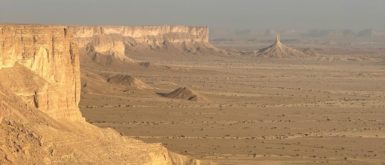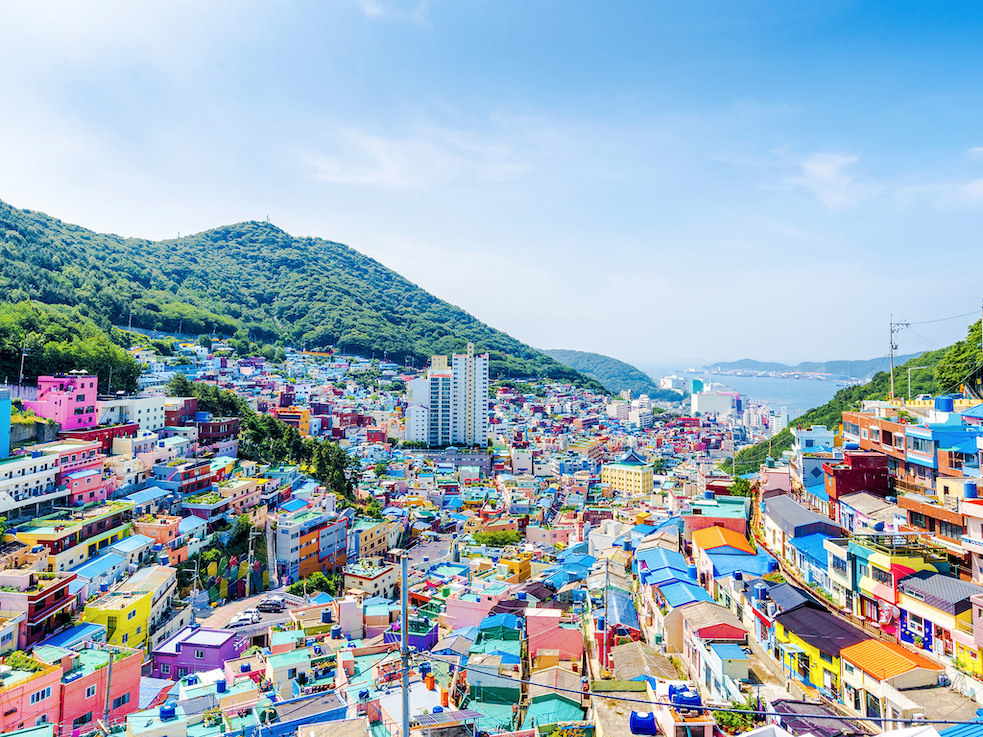 Busan, located in southern South Korea, is the second-largest city after Seoul. It is known for its beautiful beaches, bustling street markets, and delicious seafood cuisine. Whether you’re a history buff, a nature lover, or just looking for a fun weekend getaway, Busan has something for everyone. This travel guide will highlight the top 20 things to do in Busan, including must-visit attractions, delicious food, and cultural experiences.
Busan, located in southern South Korea, is the second-largest city after Seoul. It is known for its beautiful beaches, bustling street markets, and delicious seafood cuisine. Whether you’re a history buff, a nature lover, or just looking for a fun weekend getaway, Busan has something for everyone. This travel guide will highlight the top 20 things to do in Busan, including must-visit attractions, delicious food, and cultural experiences.
Haeundae Beach
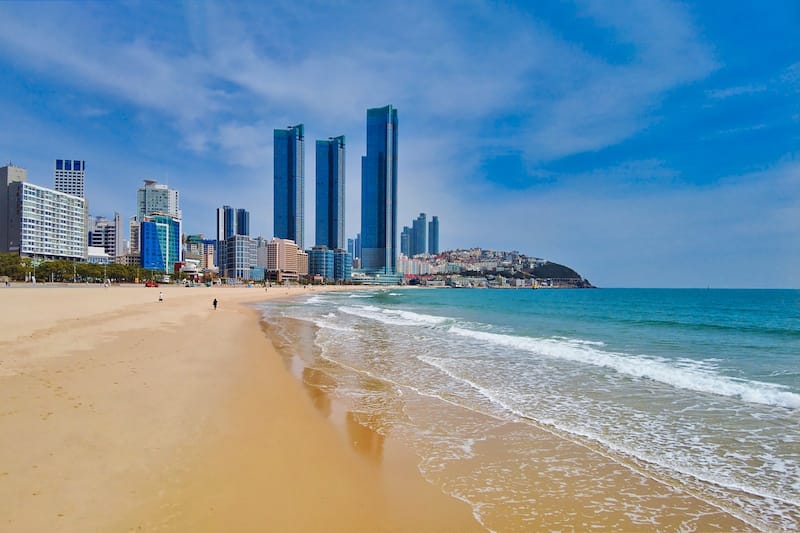 Haeundae Beach is one of the most popular attractions in Busan. It’s located in the Haeundae-gu district and is known for its beautiful sandy beach, clear blue waters, and stunning views of the surrounding mountains. Haeundae Beach is also famous for its lively atmosphere, with a wide variety of water sports, beachside bars and restaurants, and entertainment options.
Haeundae Beach is one of the most popular attractions in Busan. It’s located in the Haeundae-gu district and is known for its beautiful sandy beach, clear blue waters, and stunning views of the surrounding mountains. Haeundae Beach is also famous for its lively atmosphere, with a wide variety of water sports, beachside bars and restaurants, and entertainment options.
One of the best things about Haeundae Beach is that it’s open year-round, so you can visit at any time of the year to enjoy the beautiful scenery and activities. In the summer, the beach is crowded with locals and tourists alike, and you can enjoy a wide variety of water sports and beach activities, including swimming, kayaking, jet skiing, and parasailing. The beach also hosts a number of events and festivals throughout the year, including the Haeundae Sand Festival, which features elaborate sand sculptures created by local artists.
In addition to the beach itself, there are also several other attractions and activities to enjoy in the Haeundae-gu district. The nearby Dongbaek Island offers stunning views of the ocean and the city, walking trails and a beautiful conference center called the Nurimaru APEC House. You can also visit the Busan Aquarium, which is located on the beach and features a wide variety of marine life, including sharks, dolphins, and penguins.
If you’re interested in shopping and entertainment, the Haeundae-gu district has plenty of options. The Shinsegae Centum City is the largest shopping mall in the world. It features a wide variety of high-end shops, restaurants, and entertainment options, including an indoor ice rink and a cinema with the largest screen in the world. The Busan Cinema Center is also located in the district and hosts various film festivals and events throughout the year.
Jagalchi Market
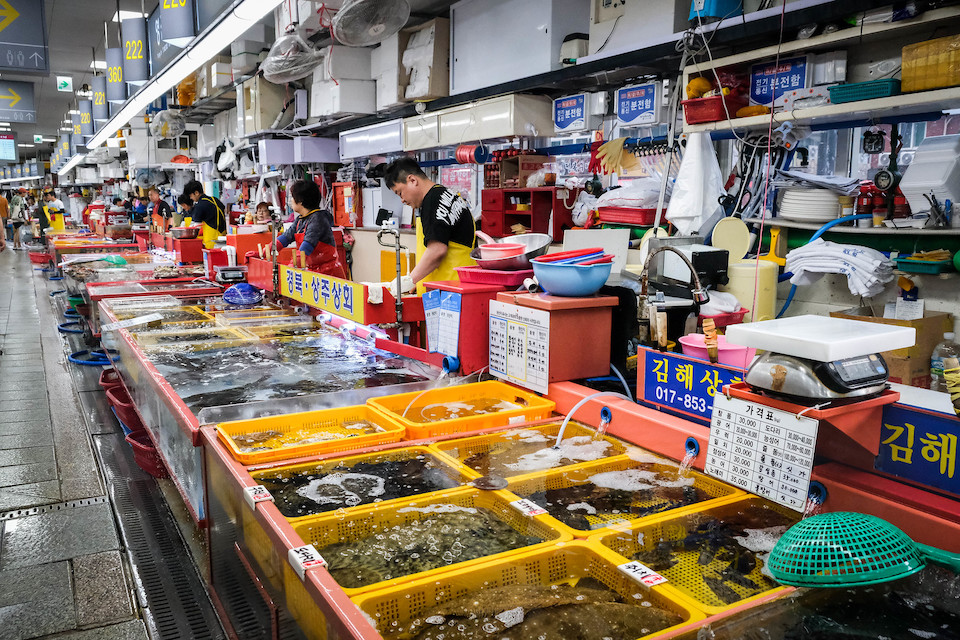 Jagalchi Market is one of the largest and most popular seafood markets in South Korea, located in the Jung-gu district of Busan. It’s a bustling and lively market that offers visitors a unique and authentic experience, with a wide variety of fresh seafood on display and plenty of restaurants and street food vendors selling delicious seafood dishes.
Jagalchi Market is one of the largest and most popular seafood markets in South Korea, located in the Jung-gu district of Busan. It’s a bustling and lively market that offers visitors a unique and authentic experience, with a wide variety of fresh seafood on display and plenty of restaurants and street food vendors selling delicious seafood dishes.
At Jagalchi Market, you can find all sorts of seafood, from fish and shellfish to octopus and squid, and even more unusual items like sea cucumbers and squirts. The vendors at the market are known for their expertise and knowledge of seafood, and they’ll be happy to offer advice on selecting and preparing the best items. You can even choose your seafood from the tanks and have it prepared for you right there on the spot.
One of the highlights of Jagalchi Market is the second floor, which is home to a large and lively indoor seafood restaurant area. Here, you can choose from various seafood dishes, including raw fish, grilled fish, fried fish, and soups. The atmosphere is lively and bustling, with vendors and servers shouting out their specials and trying to attract customers.
In addition to the seafood market and restaurants, Jagalchi Market also offers visitors several other attractions and activities. The nearby Busan International Film Festival Square features a large outdoor stage and a variety of shops and cafes. At the same time, the Gukje Market is another popular shopping destination in the area. You can also visit the nearby Busan Tower for stunning city and ocean views.
Busan Tower
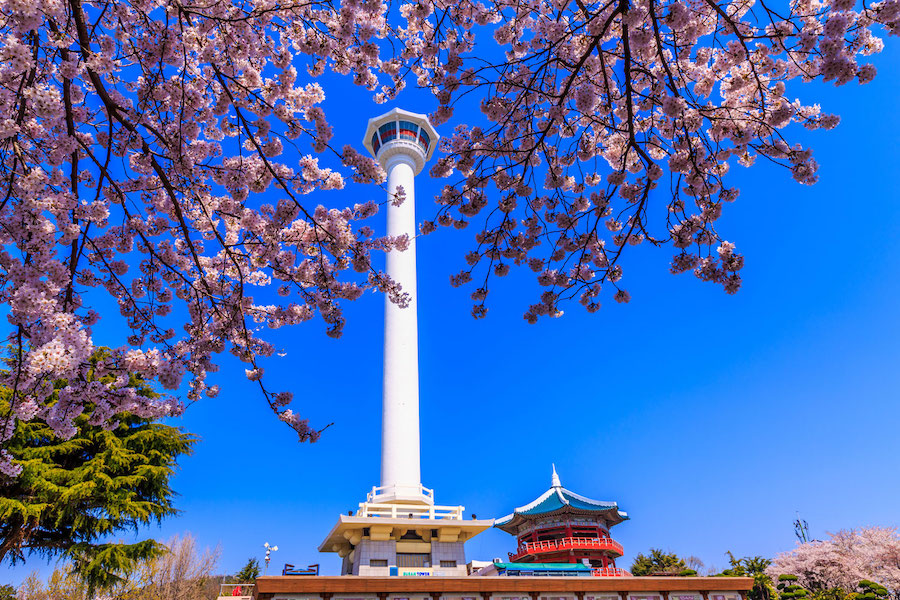 Busan Tower is one of the most iconic landmarks in Busan and is located in the Yongdusan Park in the Jung-gu district. The tower symbolizes the city and offers stunning views of Busan and the surrounding area from its observation deck, which is 120 meters above sea level.
Busan Tower is one of the most iconic landmarks in Busan and is located in the Yongdusan Park in the Jung-gu district. The tower symbolizes the city and offers stunning views of Busan and the surrounding area from its observation deck, which is 120 meters above sea level.
The tower was first built in 1973 and has since been renovated and upgraded several times. It now features a variety of attractions and activities for visitors to enjoy, including a digital observatory, a cultural exhibition hall, and a souvenir shop. The tower is also home to the Bell of the Citizens, a large bronze bell that was donated by the citizens of Busan and is rung to mark important events and celebrations.
One of the main attractions at Busan Tower is the observation deck, which offers panoramic views of the city and the ocean. Visitors can take an elevator to the top of the tower and enjoy the views from the indoor observation deck or the outdoor terrace. The digital observatory, located on the second floor, uses virtual reality technology to provide a more immersive experience of the city and its landmarks.
In addition to the observation deck and digital observatory, Busan Tower also features a cultural exhibition hall that showcases the history and culture of Busan. The exhibition includes a variety of interactive displays and multimedia exhibits that provide insight into the city’s past and present.
Busan Tower is also popular for couples, thanks to its romantic atmosphere and love lock tradition. Visitors can purchase a padlock from the souvenir shop and attach it to the fence surrounding the tower, as a symbol of their love and commitment.
Gamcheon Culture Village
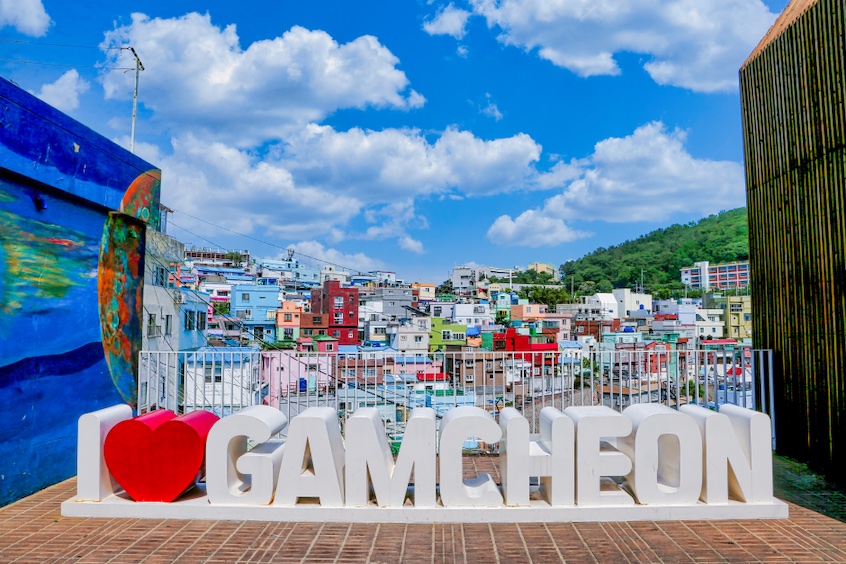 Gamcheon Culture Village is a vibrant and colorful hillside community in the Saha-gu Busan, South Korea district. Known as the “Machu Picchu of Busan,” the village is famous for its maze-like alleys, brightly colored houses, and artistic murals, making it one of the most popular tourist destinations in the city.
Gamcheon Culture Village is a vibrant and colorful hillside community in the Saha-gu Busan, South Korea district. Known as the “Machu Picchu of Busan,” the village is famous for its maze-like alleys, brightly colored houses, and artistic murals, making it one of the most popular tourist destinations in the city.
Originally a refugee settlement during the Korean War, Gamcheon Culture Village has transformed into a thriving cultural hub, thanks to a government-led project to revitalize the area in 2009. The project involved the installation of over 200 murals, sculptures, and installations throughout the village, creating a unique and visually stunning atmosphere.
One of the best ways to explore Gamcheon Culture Village is to wander through its maze-like alleys and stairways, admiring the colorful houses and art installations along the way. You can also visit some of the village’s many cafes, restaurants, and shops, which offer a variety of local snacks, souvenirs, and handicrafts.
Another popular attraction in Gamcheon Culture Village is the “Little Prince” theme park, located near the top of the hill and features a variety of exhibits and installations inspired by the famous children’s book. The theme park also offers stunning views of the city and the ocean.
If you’re interested in learning more about the history and culture of Gamcheon Culture Village, you can visit the Gamcheon Culture Village Museum, which is located near the entrance of the village. The museum features a variety of exhibits and displays that showcase the history of the village and its transformation into a cultural hub.
Taejongdae
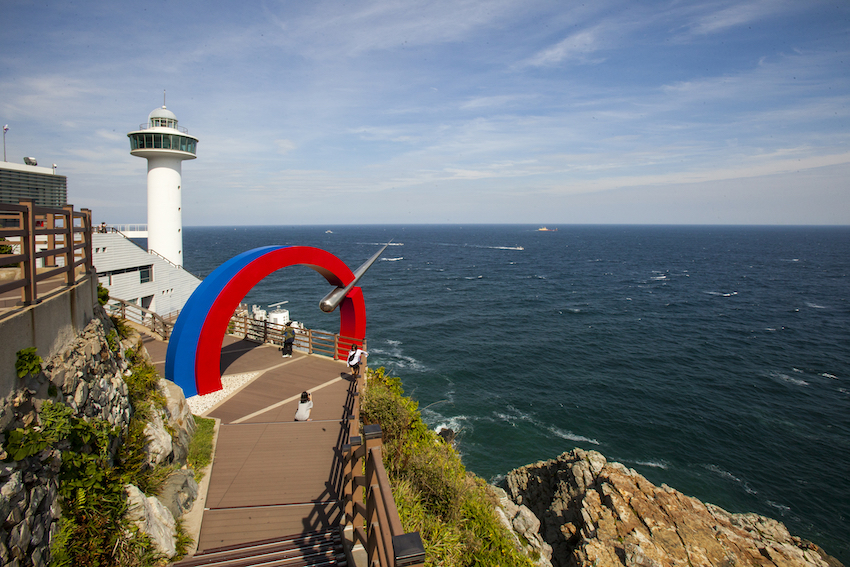 Taejongdae is a scenic natural park located at the southernmost tip of Yeongdo-gu in Busan. It is a popular tourist destination known for its breathtaking views of the ocean, cliffs, and rock formations and its historical significance.
Taejongdae is a scenic natural park located at the southernmost tip of Yeongdo-gu in Busan. It is a popular tourist destination known for its breathtaking views of the ocean, cliffs, and rock formations and its historical significance.
The park is named after King Taejong Muyeol, a king of the Silla Dynasty, and is said to have visited the area frequently to enjoy its natural beauty. Taejongdae is home to various natural and cultural attractions, including a lighthouse, a temple, and several hiking trails.
One of the main attractions at Taejongdae is the Yeongdo Lighthouse, which was first built in 1906 and is now a designated cultural asset of Busan. Visitors can climb to the top of the lighthouse for stunning views of the ocean and the surrounding area.
Another popular attraction at Taejongdae is the Danubi Train. This small train takes visitors on a scenic park tour, stopping at various points of interest along the way. The train ride is a great way to see the park’s natural beauty without having to do too much walking.
For those who enjoy hiking, Taejongdae offers several hiking trails of varying difficulty levels, ranging from short and easy walks to more challenging hikes that take several hours to complete. The trails offer stunning views of the cliffs, ocean, and rock formations and are a great way to experience the park’s natural beauty up close.
Finally, Taejongdae is also home to the Taejongsa Temple, a small Buddhist temple that was first built in 1396 and has been rebuilt several times. The temple offers a peaceful and serene atmosphere, and visitors can participate in Buddhist rituals and activities, such as meditation and prayer.
Gukje Market
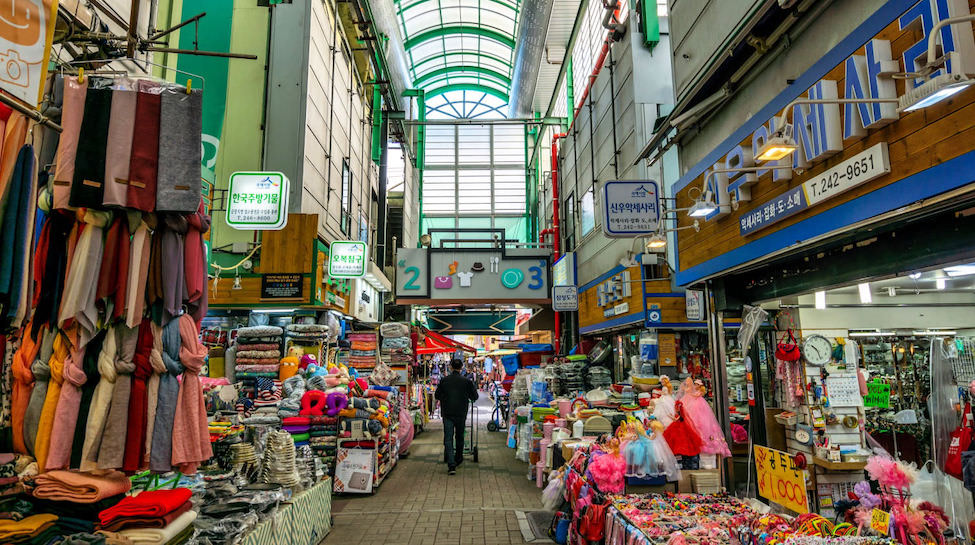 Gukje Market is one of the largest traditional markets known for its bustling atmosphere, authentic Korean street food, and affordable shopping. The market has a long history, dating back to the Korean War when it was founded by refugees who came to Busan to escape the fighting.
Gukje Market is one of the largest traditional markets known for its bustling atmosphere, authentic Korean street food, and affordable shopping. The market has a long history, dating back to the Korean War when it was founded by refugees who came to Busan to escape the fighting.
Today, Gukje Market is a vibrant hub of activity, with over 1,000 shops and vendors selling everything from clothing, shoes, and accessories to electronics, household goods, and traditional Korean crafts. Visitors can browse through the narrow alleys and maze-like streets of the market, bargaining with vendors and searching for unique souvenirs and gifts.
One of the highlights of Gukje Market is its food scene, with dozens of food stalls and restaurants serving up a variety of Korean street food and snacks, such as tteokbokki (spicy rice cakes), hotteok (sweet pancakes), and eomuk (fish cakes). Visitors can try out different dishes and flavors and soak up the lively and authentic atmosphere of the market.
In addition to shopping and eating, visitors to Gukje Market can also explore some of the market’s cultural and historical attractions. The market is home to the Gukje Market History Museum, which features exhibits and displays that showcase the market’s history and cultural significance. Visitors can also check out the nearby BIFF Square, home to the Busan International Film Festival and various movie-related attractions, such as a Walk of Fame and a movie-themed street.
Beomeosa Temple
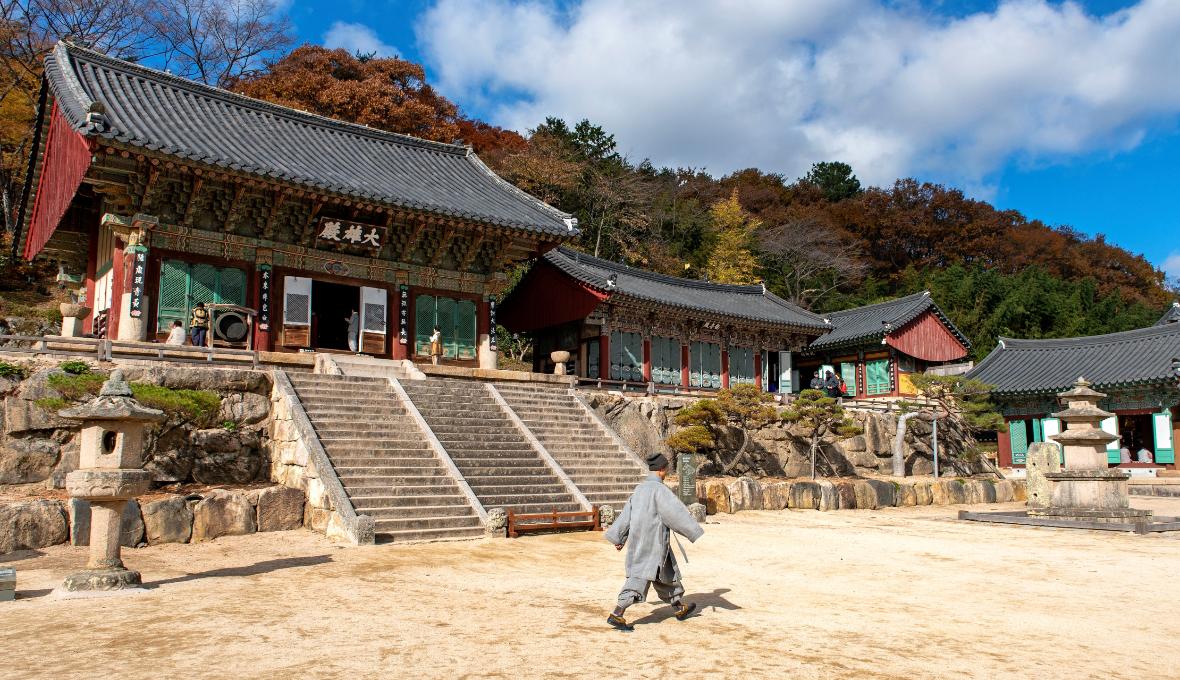 Beomeosa Temple is one of the most important Buddhist temples in South Korea, located on the slopes of Mount Geumjeongsan in Busan. It was founded in 678 AD during the reign of the Silla Kingdom, and has been destroyed and rebuilt several times throughout history. Today, it is considered one of the three jewels of Korean Buddhism, along with Haeinsa Temple and Tongdosa Temple.
Beomeosa Temple is one of the most important Buddhist temples in South Korea, located on the slopes of Mount Geumjeongsan in Busan. It was founded in 678 AD during the reign of the Silla Kingdom, and has been destroyed and rebuilt several times throughout history. Today, it is considered one of the three jewels of Korean Buddhism, along with Haeinsa Temple and Tongdosa Temple.
The temple complex is set among beautiful natural surroundings, with a winding stream and lush forests. Visitors can explore the complex’s many buildings and structures, adorned with colorful paintings, intricate carvings, and elaborate decorations. Some of the highlights include the Main Hall, which houses a statue of Buddha and other important religious artifacts, the Three-story Stone Pagoda and the Beomeosa Museum of Buddhism Art.
Visitors to Beomeosa Temple can also participate in various Buddhist practices and rituals, such as meditation and chanting, and learn about the teachings of Buddhism from the resident monks. The temple offers a peaceful and serene atmosphere, with the sound of chanting and the scent of incense filling the air.
For those who enjoy hiking and outdoor activities, Beomeosa Temple is also a great starting point for exploring Mount Geumjeongsan. The mountain offers several hiking trails of varying difficulty levels, ranging from easy walks to more challenging hikes that take several hours to complete. Along the way, hikers can enjoy stunning views of the surrounding mountains and the city of Busan.
Haedong Yonggungsa Temple
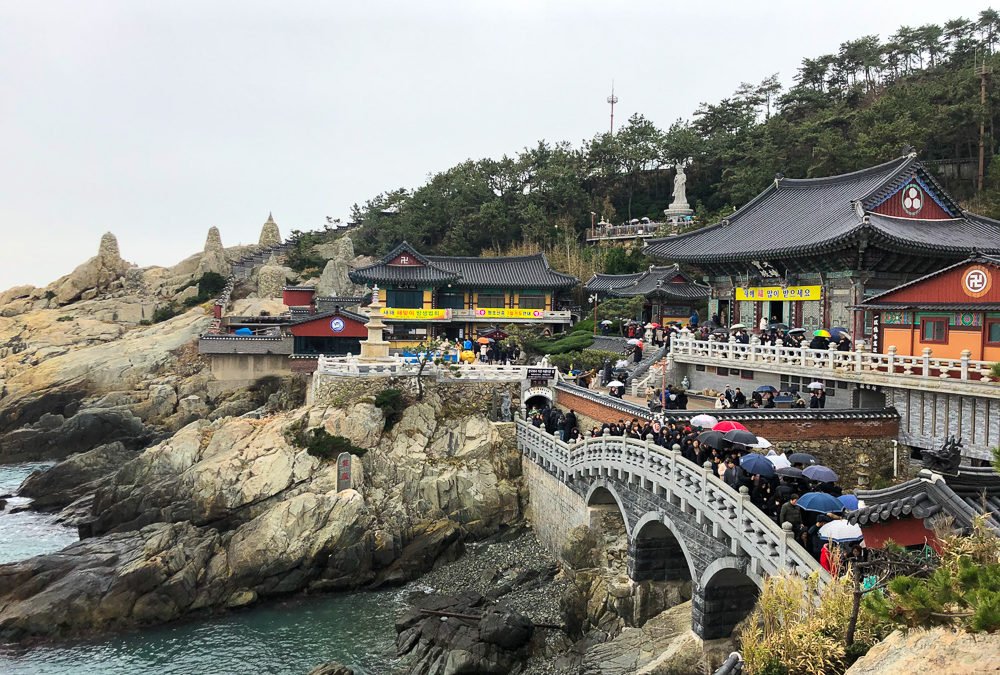 Haedong Yonggungsa Temple is a unique and picturesque temple located on the coast of the East Sea. Unlike most other temples in the country that are nestled in the mountains, Haedong Yonggungsa is built right by the sea, offering stunning views of the ocean and the surrounding cliffs.
Haedong Yonggungsa Temple is a unique and picturesque temple located on the coast of the East Sea. Unlike most other temples in the country that are nestled in the mountains, Haedong Yonggungsa is built right by the sea, offering stunning views of the ocean and the surrounding cliffs.
The temple was first built in 1376 during the Goryeo Dynasty but was destroyed during the Japanese invasions of the late 16th century. It was rebuilt in the 1930s and has since become one of Busan’s most popular tourist destinations, attracting visitors from all over the world.
Haedong Yonggungsa is known for its beautiful and unique architecture, which combines traditional Korean and Buddhist design elements with modern touches. The temple complex features several buildings, including the Main Hall, the Three-story Pagoda, and the Great Goddess of Mercy Statue, all adorned with colorful decorations and intricate carvings.
One of the most popular attractions at Haedong Yonggungsa is the 108 steps that lead down to the temple from the parking lot. The steps are adorned with stone lanterns and offer breathtaking views of the ocean and the surrounding cliffs. Visitors can also explore the temple’s many shrines, gardens, and meditation halls and participate in various Buddhist practices and rituals, such as chanting and meditation.
Another highlight of Haedong Yonggungsa is the annual New Year’s Sunrise Festival. Thousands of visitors gather to watch the year’s first sunrise over the sea while enjoying traditional Korean food and performances.
Songdo Beach
Songdo Beach is a popular urban beach in the Seo-gu district. It is known for its unique skywalk, which extends over the ocean and offers breathtaking views of the surrounding coastline.
The beach is easily accessible by public transportation and offers a variety of amenities for visitors, including showers, changing rooms, and beachfront restaurants. The water at Songdo Beach is relatively calm and clear, making it a popular destination for swimming, snorkeling, and other water activities.
One of the unique features of Songdo Beach is the Songdo Skywalk, a curved and transparent walkway that extends out over the ocean for nearly 400 meters. Visitors can stroll along the skywalk while enjoying panoramic views of the coastline and the East Sea. At the end of the skywalk is a large observation deck offering even more stunning views of the ocean and the nearby mountains.
Another popular attraction at Songdo Beach is the cable car, which takes visitors on a scenic ride from the beach to the top of the nearby Mount Cheonma. The cable car offers stunning views of the ocean and the surrounding city and is a great way to get a bird’s eye view of the area.
For those who enjoy hiking and nature, Songdo Beach is also a great starting point for exploring the nearby Taejongdae Park. The park offers several hiking trails of varying difficulty levels and stunning views of the ocean and the surrounding mountains.
Yongdusan Park
Yongdusan Park is a large public park located in the Jung-gu district. The park is known for its stunning views of the city and the surrounding mountains and its many attractions, including the Busan Tower, the Museum of World Folk Instruments, and the Busan Modern History Museum.
One of the main attractions at Yongdusan Park is the Busan Tower, a 120-meter tall observation tower that offers panoramic views of the city and the surrounding mountains. Visitors can take the elevator to the top of the tower, where they can enjoy stunning views of the city and the ocean from the observation deck.
Another popular attraction at Yongdusan Park is the Museum of World Folk Instruments, which houses a collection of more than 1,500 musical instruments from around the world. The museum features exhibits on the history and culture of music, interactive displays, and live performances.
The Busan Modern History Museum is also located in Yongdusan Park and offers exhibits on the history of Busan and its role in the modernization of Korea. The museum exhibits various aspects of Busan’s history, including its role as a trading port, cultural heritage, and modernization after the Korean War.
In addition to its many attractions, Yongdusan Park is a popular destination for outdoor activities and relaxation. The park features several walking trails and a large grassy area for picnics and outdoor games. The park also has several cafes and restaurants where visitors can enjoy refreshments while enjoying the city’s views and the mountains.
Dongbaek Island
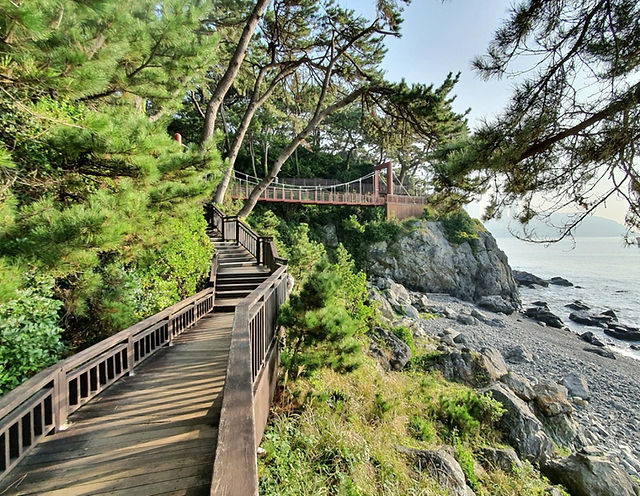 Dongbaek Island is a small island located in Haeundae-gu. The island is known for its beautiful coastal scenery, hiking trails, and cultural significance.
Dongbaek Island is a small island located in Haeundae-gu. The island is known for its beautiful coastal scenery, hiking trails, and cultural significance.
One of the main attractions on Dongbaek Island is the APEC Naru Park, a large park built for the 2005 APEC Summit. The park features several walking trails and gardens and a statue of the goddess of the sea, a popular spot for photos. Visitors can also enjoy stunning views of Haeundae Beach and Gwangan Bridge from the park.
Another popular attraction on Dongbaek Island is the Nurimaru APEC House, which was used as a meeting place during the 2005 APEC Summit. The building is now open to the public and features exhibits on the history and culture of Korea. Visitors can also enjoy views of the surrounding coastline from the building’s observation deck.
Dongbaek Island offers several hiking trails with varying difficulty levels for those interested in hiking. One of the most popular trails is the Dongbaekseom Island Loop Trail, a 1.5-kilometer trail that takes visitors around the island’s perimeter. Visitors can enjoy stunning views of the ocean and the surrounding coastline along the trail.
Dongbaek Island is also known for its cultural significance. The island is believed to be the birthplace of the legendary princess Heo Hwang-ok, who is said to have married the king of the ancient Indian kingdom of Ayodhya. Visitors can learn more about the legend of Princess Heo at the Dongbaekseom Exhibition Hall, which features exhibits on her life and legacy.
Centum City
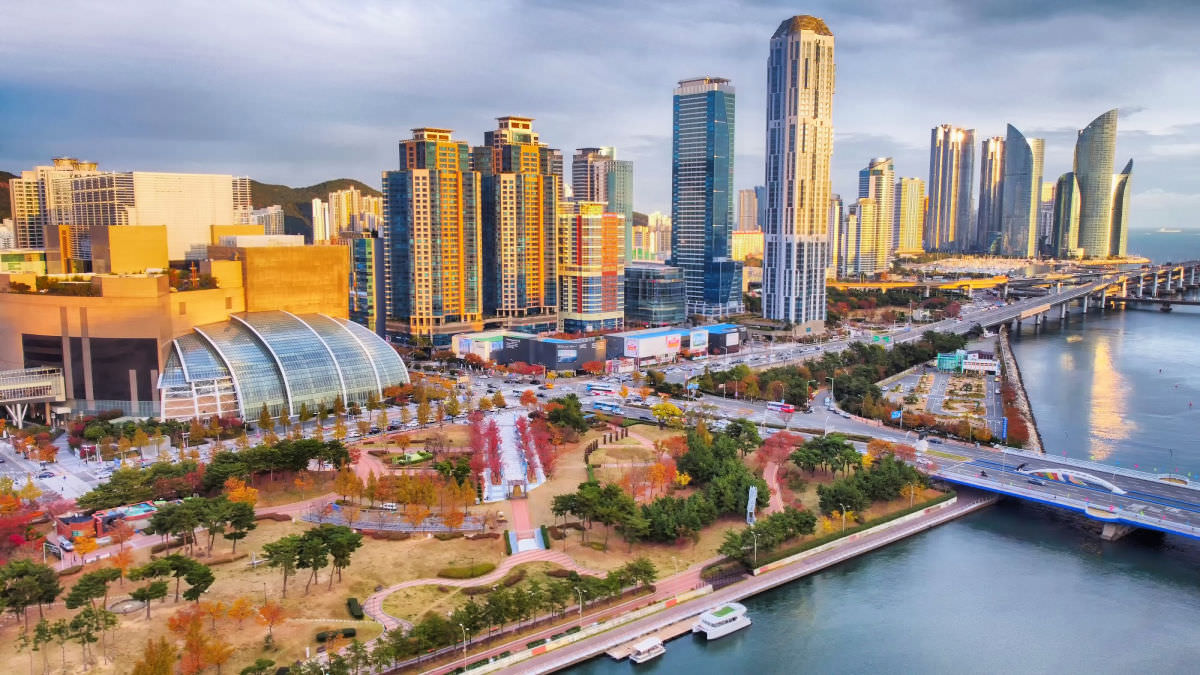 Centum City is a large commercial and residential complex located in Haeundae-gu. The complex is known for its shopping centers, cultural attractions, and entertainment facilities.
Centum City is a large commercial and residential complex located in Haeundae-gu. The complex is known for its shopping centers, cultural attractions, and entertainment facilities.
One of the main attractions in Centum City is the Shinsegae Centum City Department Store, which is the largest department store in the world. The store features several floors of high-end luxury brands, a food court and a movie theater. Visitors can also enjoy stunning city views from the store’s rooftop garden.
Another popular attraction in Centum City is the Busan Cinema Center, a state-of-the-art movie theater and cultural center. The center features several movie theaters and an outdoor theater that can seat up to 4,000 people. The center also hosts annual cultural events, including film festivals and concerts.
For those interested in history, Centum City also features the Busan Museum of Art, which features exhibits on contemporary art and Korean culture. The museum has a collection of more than 4,000 works of art, including paintings, sculptures, and installations.
Centum City is also a popular destination for shopping and dining. The complex features several shopping centers, including the Centum City Mall and the Lotte Department Store, as well as numerous restaurants and cafes.
Seomyeon
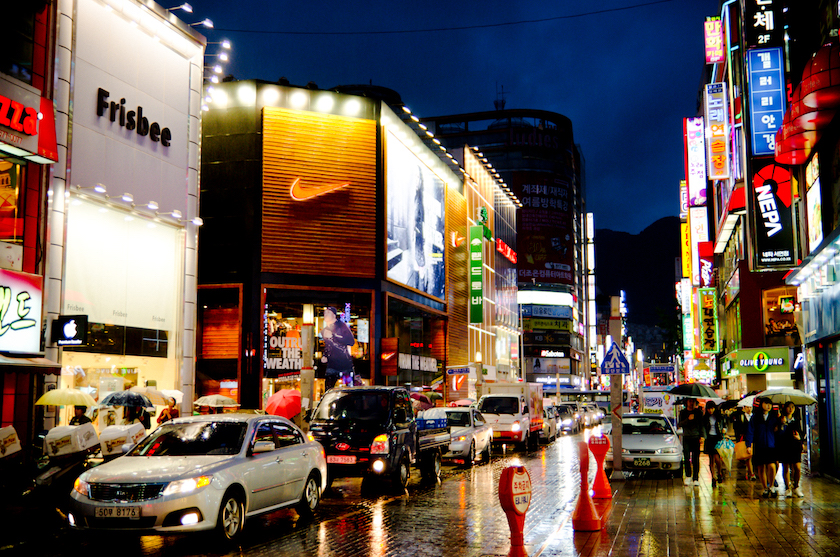 Seomyeon is a bustling neighborhood. The neighborhood is known for its shopping, dining, nightlife, and central location.
Seomyeon is a bustling neighborhood. The neighborhood is known for its shopping, dining, nightlife, and central location.
One of the main attractions in Seomyeon is the Seomyeon Underground Shopping Center, one of Asia’s largest underground shopping centers. The center features over 1,000 shops and restaurants, a movie theater, and an arcade.
Seomyeon is also a popular destination for foodies. The neighborhood is known for its street food, traditional Korean cuisine, and trendy cafes and restaurants. Some must-try dishes in Seomyeon include bibimbap, a Korean rice dish with vegetables and meat, and tteokbokki, a spicy rice cake dish.
Seomyeon also features several bars, clubs, and karaoke rooms for those interested in nightlife. The neighborhood is particularly popular with younger crowds and is known for its lively and energetic atmosphere.
In addition to its shopping and dining options, Seomyeon also features several cultural attractions. The Busan Citizens’ Hall is a popular venue for concerts and performances, while the Gwangalli Eobang Festival celebrates the region’s fishing heritage with traditional music, dance, and food.
Busan Museum
Busan Museum is located in the heart of Busan. The museum showcases the history and culture of the city and is a must-visit destination for anyone interested in learning about the region’s past.
The museum features several permanent and rotating exhibits highlighting Busan’s history and culture. The permanent exhibits include a collection of artifacts from the ancient kingdom of Silla, which ruled the region from the 4th to the 7th century.
The museum also has a large collection of artifacts from the Japanese colonial period, which lasted from 1910 to 1945. These artifacts include items related to the Korean independence movement and everyday objects used by ordinary people during this period.
One of the most popular exhibits at the Busan Museum is the Gyeongju National Museum Annex, which features artifacts from the ancient Silla capital of Gyeongju. The exhibit includes a collection of gold artifacts, including crowns, earrings, and belts worn by the Silla nobility.
In addition to its exhibits, the Busan Museum also features several educational programs and events throughout the year. These include guided tours, workshops, and cultural performances.
Hwamyeong Ecological Park
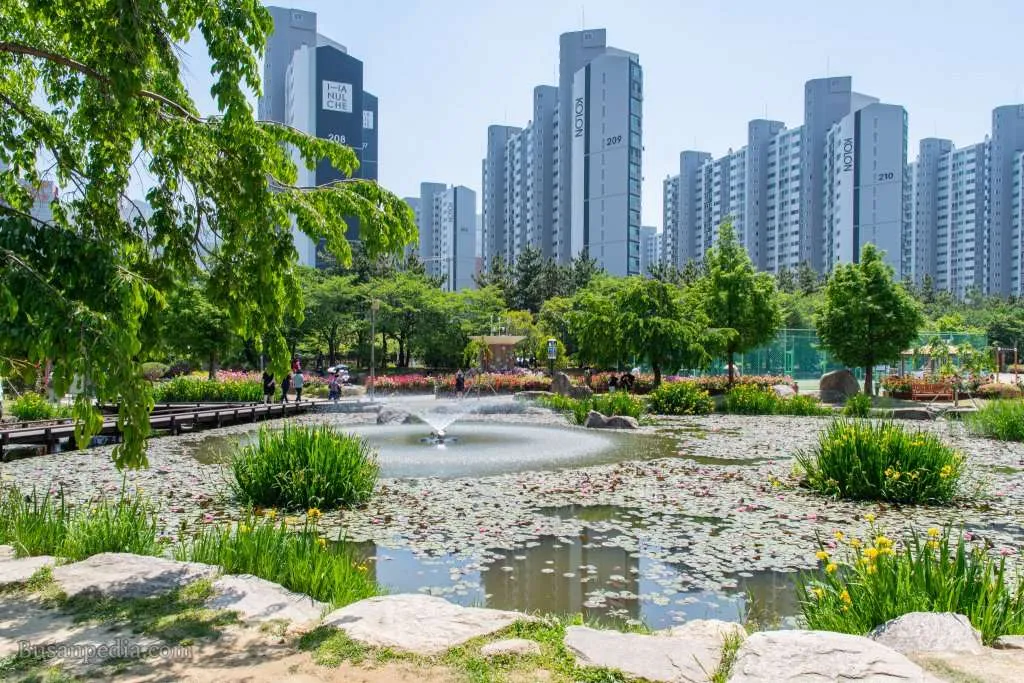 Hwamyeong Ecological Park is a large park located in the Hwamyeong-dong neighborhood. The park is known for its beautiful natural scenery and diverse plant and animal life.
Hwamyeong Ecological Park is a large park located in the Hwamyeong-dong neighborhood. The park is known for its beautiful natural scenery and diverse plant and animal life.
The park covers an area of approximately 88 hectares and includes several hiking trails, picnic areas, and playgrounds. The park is home to various plant species, including cherry blossoms, magnolias, and camellias, which bloom in the spring and add to the park’s natural beauty.
The park is also home to various animal species, including rabbits, squirrels, chipmunks, and several species of birds. Visitors to the park can enjoy bird watching, fishing, and other outdoor activities.
One of the park’s highlights is the Hwamyeong Arboretum, which features a collection of over 700 plant species from around the world. The arboretum includes several gardens: a rose garden, a tropical plant garden, and a cactus garden.
The park also has several cultural and educational facilities, including the Hwamyeong Cultural Center, which features exhibitions and performances showcasing the region’s culture and history.
Gwangalli Beach
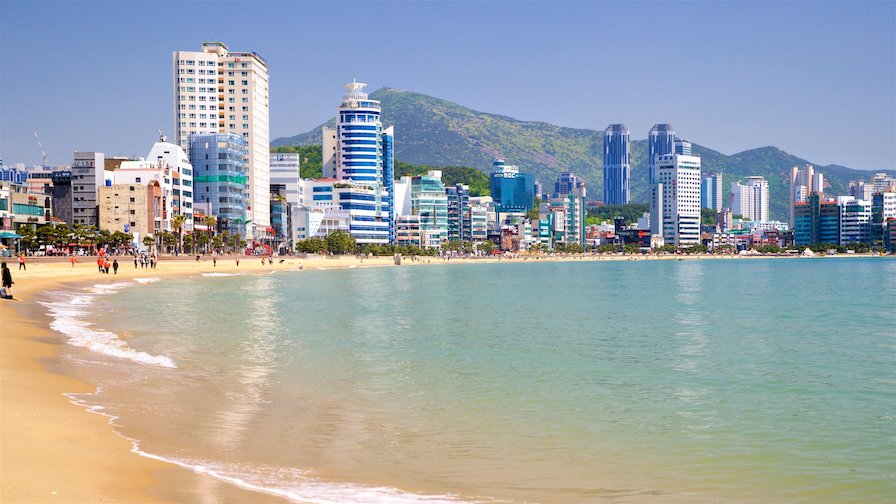 Gwangalli Beach is a popular beach located in the Gwangan-dong neighborhood. The beach is known for its beautiful scenery, clear water, and lively atmosphere.
Gwangalli Beach is a popular beach located in the Gwangan-dong neighborhood. The beach is known for its beautiful scenery, clear water, and lively atmosphere.
The beach covers a stretch of 1.4 kilometers and features soft white sand, clear blue water, and panoramic city skyline views. The beach is a popular destination for swimming, sunbathing, and water sports, including jet skiing and paddle boarding.
One of the highlights of Gwangalli Beach is the Gwangan Bridge, which stretches over the beach and offers a stunning backdrop for photos and sunset views. The bridge is illuminated at night, creating a beautiful and romantic atmosphere for evening strolls along the beach.
The beach also features several restaurants and cafes, offering a variety of local and international cuisine and a lively nightlife scene with bars and nightclubs that stay open late.
In addition to its natural beauty and entertainment offerings, Gwangalli Beach is known for its annual events, including the Busan Fireworks Festival and the Gwangalli Eobang Festival, which celebrate the region’s culture and history.
Oryukdo Skywalk
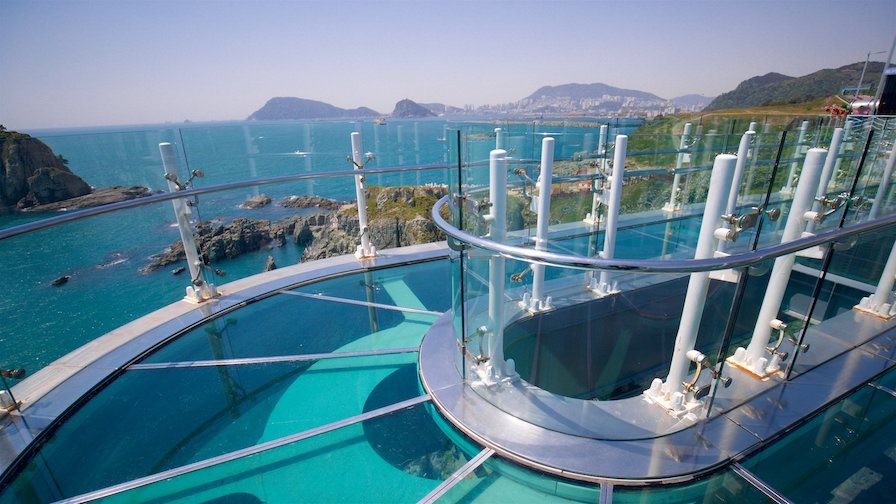 The Oryukdo Skywalk is a popular attraction in Busan’s Igidae Park area. The Skywalk is a glass bridge that extends out from a cliff, offering visitors breathtaking views of the ocean and surrounding coastline.
The Oryukdo Skywalk is a popular attraction in Busan’s Igidae Park area. The Skywalk is a glass bridge that extends out from a cliff, offering visitors breathtaking views of the ocean and surrounding coastline.
The Skywalk is 15 meters long and extends out from a cliff, suspended 35 meters above the ocean. The glass floor allows visitors to look down and see the waves crashing below their feet, creating a thrilling and unforgettable experience.
In addition to the skywalk, the area offers several hiking trails that lead through the Igidae Park and offer stunning views of the coastline and surrounding natural scenery.
Visitors can also enjoy other activities, including fishing, kayaking, and biking. The nearby Dongbaek Island and Haeundae Beach are also popular destinations for visitors looking for more outdoor activities and stunning views.
Busan International Film Festival
The Busan International Film Festival is one of Asia’s most prestigious film festivals, held annually in October. It features a wide variety of international and Korean films, workshops, seminars, and other events. If you’re a film buff, this is a great opportunity to see some of the best films from around the world.
Kukje Market Food Alley
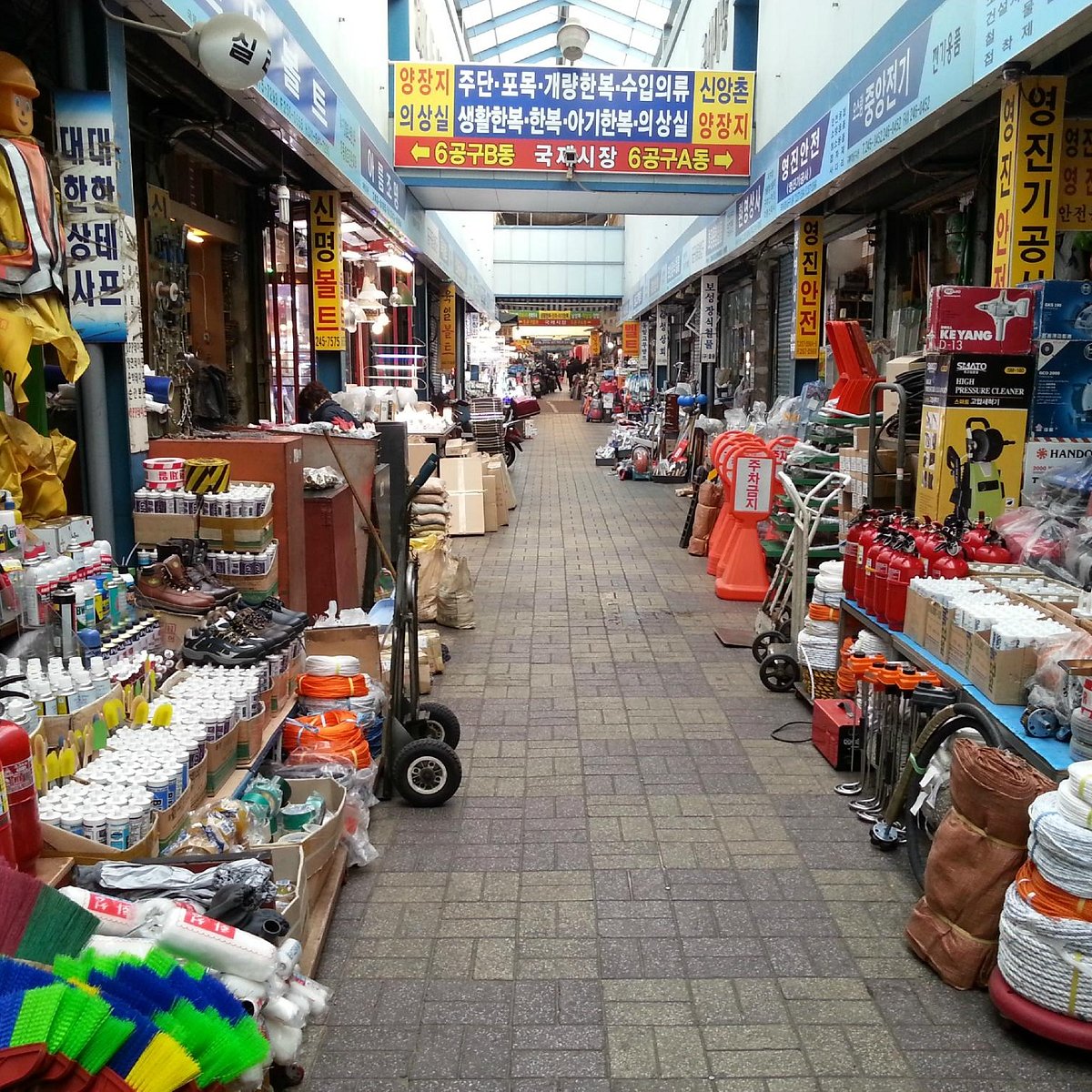 Kukje Market is one of the largest traditional markets in Busan, South Korea, and is a popular destination for shopping and food. The market’s food alley is a must-visit destination for anyone interested in sampling traditional Korean street food.
Kukje Market is one of the largest traditional markets in Busan, South Korea, and is a popular destination for shopping and food. The market’s food alley is a must-visit destination for anyone interested in sampling traditional Korean street food.
The food alley features numerous food stalls and vendors selling a variety of Korean specialties, including tteokbokki (spicy rice cakes), gimbap (rice and seaweed rolls), sundae (blood sausage), mandu (dumplings), and hotteok (sweet pancakes filled with brown sugar and nuts).
One of the most popular dishes at Kukje Market’s food alley is the eomuk (fish cake). Eomuk is a Korean fish cake that is skewered and grilled to perfection. It is often served with a sweet and savory soy sauce-based broth and is a favorite among locals and tourists.
Another popular dish at the food alley is the bindaetteok (mung bean pancake). The pancake is made from ground mung beans mixed with vegetables and spices before being fried to a crispy golden brown. It is often served with a spicy dipping sauce and is a popular snack or meal option.
In addition to the delicious food, the food alley also offers a unique and vibrant atmosphere. The market is busy and crowded, with vendors shouting out their specials and customers bargaining for the best prices. The food alley’s sights, sounds, and smells are a sensory experience that is not to be missed.
Jalgachi Market Seafood Restaurants
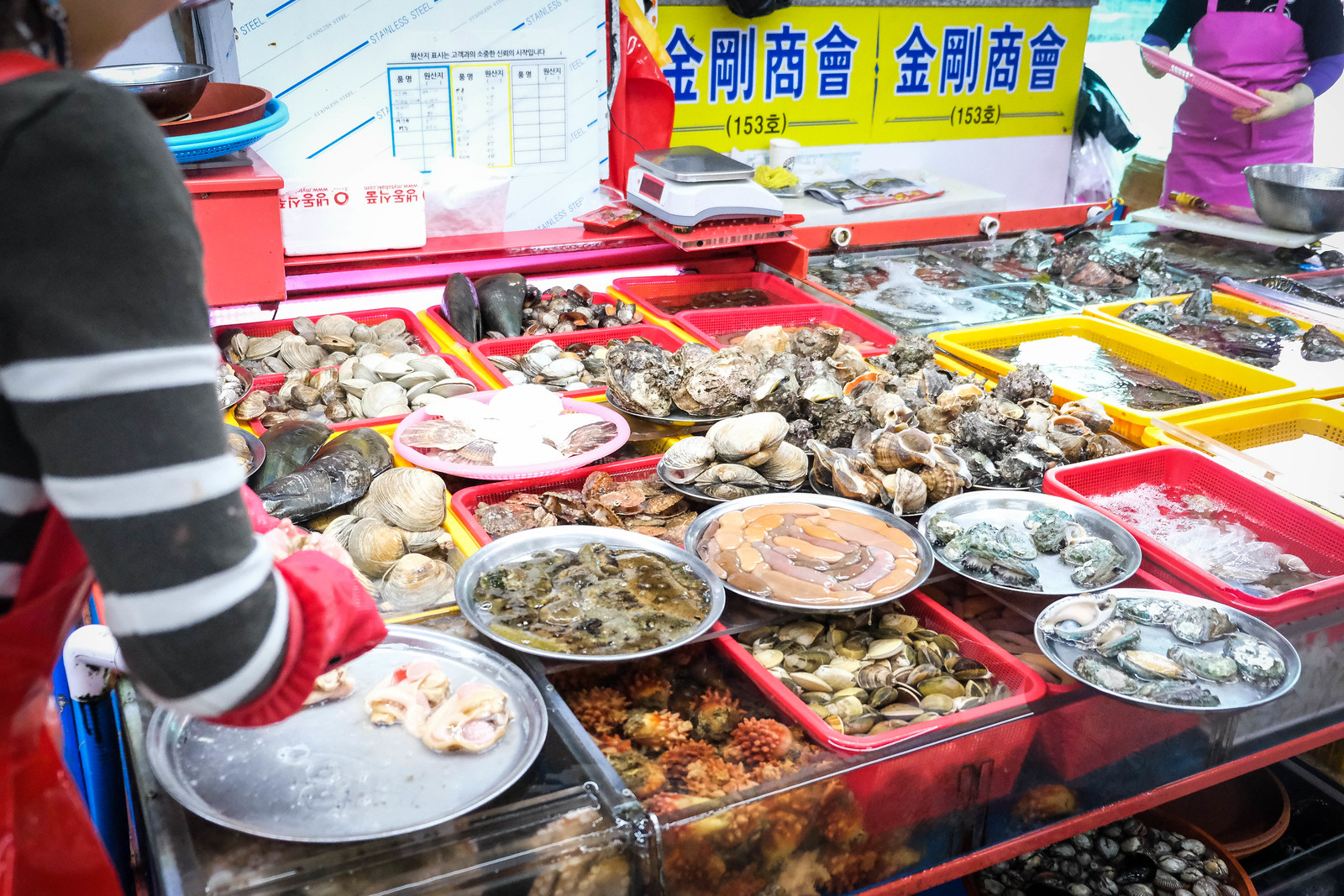 Jagalchi Market is the largest seafood market in Busan, South Korea, and is a popular destination for locals and tourists. In addition to the seafood vendors selling fresh fish and other seafood, the market is also home to numerous seafood restaurants that serve up some of the freshest and most delicious seafood in the city.
Jagalchi Market is the largest seafood market in Busan, South Korea, and is a popular destination for locals and tourists. In addition to the seafood vendors selling fresh fish and other seafood, the market is also home to numerous seafood restaurants that serve up some of the freshest and most delicious seafood in the city.
The restaurants at Jagalchi Market offer a variety of seafood dishes, including raw fish, grilled fish, seafood stew, and sashimi. One of the most popular dishes is the hoe (raw fish). The restaurant will often prepare the fish before you, ensuring it is as fresh as possible. Other popular dishes include grilled mackerel, seafood pancakes, and spicy seafood soup.
One of the unique features of the restaurants at Jagalchi Market is the ability to pick out your own seafood from the vendors and have it cooked to order at the restaurant. This ensures you get the freshest possible seafood and allows you to try some of the more unusual and rare seafood that may not be available in other restaurants.
The restaurants at Jagalchi Market offer a unique dining experience, with most of the restaurants located on the market’s second floor and offering views of the sea and fishing boats. The atmosphere is lively and bustling, with the sounds of vendors hawking their wares and customers haggling for the best prices.
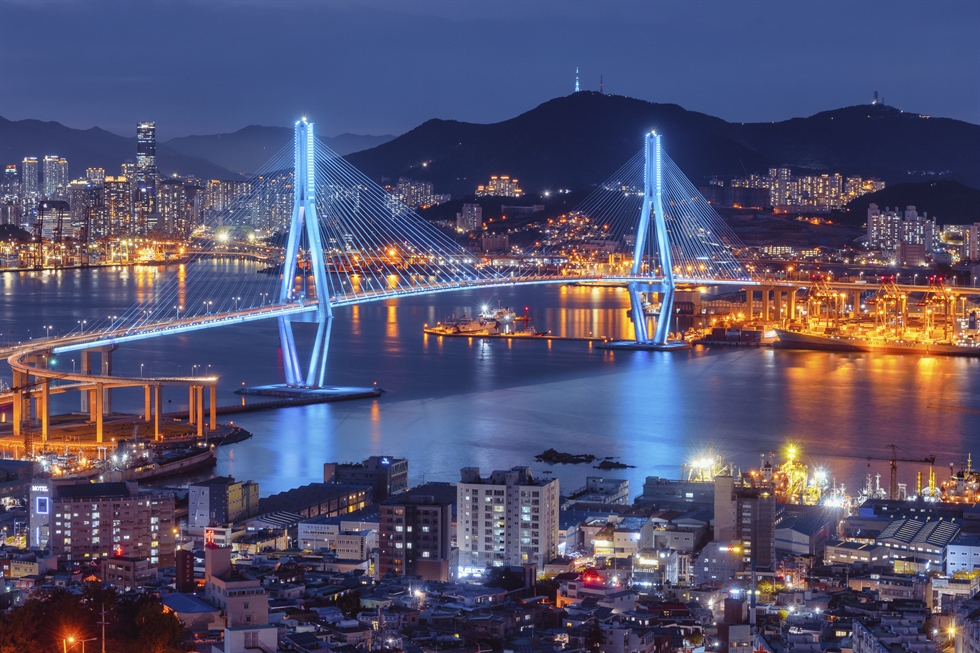 Busan is a vibrant and exciting city that offers a wide variety of attractions and activities for visitors. From its beautiful beaches and parks to its bustling markets and modern shopping malls, there is something for everyone to enjoy. Whether you’re interested in history and culture, nature and outdoor activities, or food and entertainment, you will surely find plenty of things to do in Busan.
Busan is a vibrant and exciting city that offers a wide variety of attractions and activities for visitors. From its beautiful beaches and parks to its bustling markets and modern shopping malls, there is something for everyone to enjoy. Whether you’re interested in history and culture, nature and outdoor activities, or food and entertainment, you will surely find plenty of things to do in Busan.
Planning ahead and prioritizing the attractions and activities you’re most interested in is a good idea to make the most of your visit to Busan. With so many options available, it can be difficult to see everything in just one trip, so choose wisely and allow plenty of time to explore each area fully. Whether traveling solo, with friends, or with family, Busan is a great destination that will leave you with lasting memories and a desire to return again and again.
Be sure to check out our vlog The Go To Family. Connect with us on Instagram, Twitter, and Pinterest !


